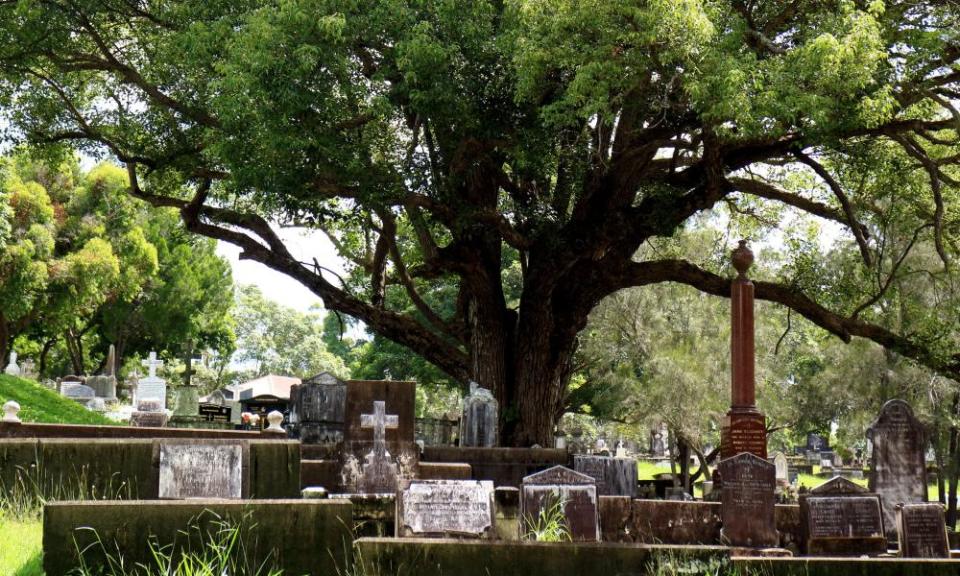Cemeteries are peaceful, open spaces – they can be for the living too

Is there any better way to feel connected with the meaning of life as by walking among the dead?
Every time I wander through the cemetery near my inner city Brisbane house, I think about the people who once walked the land upon which I now walk, who were warmed by the same sun.
Among the graves of those lost in war, I learn of bravery and tragedy. When I pass by small stones raised to lost children, I contemplate pain, suffering and loss.
Reading of a dearly beloved husband and father and grandfather fills me with thoughts of a long life filled with joy and sadness, triumph and disappointment.
And when I find inscriptions written in languages other than my own, or expressions of faith different from the one I was brought up with, I reflect on the great differences of life, and the oneness of death, and the marvel of us all sharing space, both within and beyond the cemetery walls.
From Toowong and South Brisbane to Brookfield and Bald Hills, Brisbane has some remarkable cemeteries. But are we the living making the most of these expansive, tree-lined spaces?
Cemeteries exist in the same dense, land-locked suburbs where people feel short on space to move and meet each other. Cemeteries tend to be large. Cemeteries might be council-run, and come with parking spaces and bathroom facilities and drinking water fountains. Cemeteries tend to be peaceful, contemplative places, and might have tall trees, meandering paths, manicured lawns and ponds, and, in some cases, kangaroos, possums, ducks and frogs. And people who visit people they care for. In other words, cemeteries are the perfect antidote to the chaos of crowded, high-density, disconnected living.

I think about this when I go to visit Nan and Grandad at their place of eternal rest. I don’t visit often enough, but when I do, I’m glad for this space of quiet repose. They are buried on church grounds, and I like the idea they watch bridal parties come and go; hear families celebrating christenings, and counsel mourners grieving the loss of another loved one. When I visit, I kiss their headstones and trace the letters of their names – the shared letters of our family name – and I miss them and love them and feel grounded in the dirt around them. Sometimes I bring my young daughter, although she never knew Nan, and barely remembers Grandad. Mostly, I go alone.
Cemeteries are places for mourning. And that must be respected.
Related: Burial ground zero: the crisis facing Sydney's cemeteries
But cemeteries also have a history as recreational places, central to community life. In his study of American cemeteries, Keith Eggener points out that large cemeteries built in American cities during the 1830s filled a void later addressed by public art galleries and parks. They were places for funerals, as well as picnicking, hunting and carriage racing. They were so popular, guidebooks were issued. Indeed, in Brisbane today, you can take a guided tour of some historic cemeteries; some are self-guided, others are conducted in groups. Clearly there’s still an interest in cemeteries that goes beyond their primary purpose.
So what more could be done? Well, a swing set under a shade sail and some more bubblers would be a start. We could welcome public lectures, art classes or meditation meets, and consider the magic of concerts in cemeteries (just to be clear: I’m thinking more string quartet than stage spectacular). Underground opera in the old Spring Hill Reservoir, for example, has transformed a place rich in heritage value but poor in public relevance into a beacon of Brisbane’s cultural landscape.
As ever, it all comes down to balance. Living beings are complex, different and demanding – we want to live in the city, but we want big open spaces to play in. We want space for ritual, religious practices, rites of passage, and reflection, but we can’t all agree on the hows, wheres and whys. I want to respectfully reimagine cemeteries, but I recognise many are happy with them exactly how they are. And that’s OK. I’m sure there’s one thing on which we can agree: that we all hope to one day rest in peace.
Katherine Feeney is a journalist and broadcaster who presents Afternoons on ABC Radio Brisbane.

 Yahoo Movies
Yahoo Movies 
